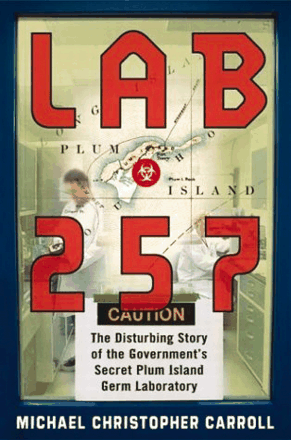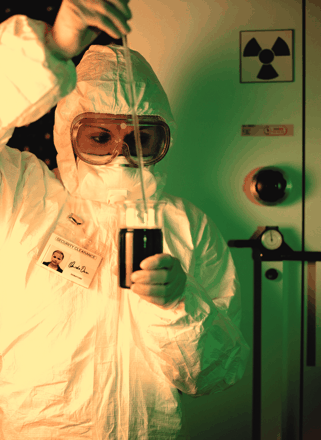Frankenstein’s Castle (On Long Island)
- Dan Collinge, BA
Lab 257: The Disturbing Story of the Government’s Secret Plum Island Germ Laboratory. Michael C. Carroll New York: William Morrow; 2004. 320 pages. $24.95 ISBN: B0002TX4I4

The North Fork of Long Island: a pastoral utopia of small towns and farm fields, the summer playground for the super rich, the home of some of the deadliest animal viruses known to man. Plum Island, barely a mile removed from the bulk of Long Island and some eighty miles distant from the densest population zone in the United States, seems an unlikely setting for a germ warfare lab, let alone one with a checkered past and a long list of safety violations. But then again, Plum Island’s history is one of contradictions, deceptions, and eye-opening facts. Scientific truth, Michael Christopher Carroll argues, is often stranger than science fiction. Lab 257: The Disturbing Story of the Government’s Secret Plum Island Germ Laboratory is an exhaustive account of the history of Plum Island Animal Disease Center—from conception to (mis) management, from scientific breakthroughs to suspicious disease outbreaks and “biological meltdowns.” Carroll sets his inquiry against the background of a post-9/11, terrorist- weary world, while asking the question: is such a place necessary and, if so, how can we make it safer?

Plum Island’s lab came into being shortly after the end of World War II, when the United States government decided it needed a research facility to study potential uses for and defenses against germs as biological weapons. The Soviet Union, too, had begun such initiatives, and Germany’s programs before and during World War II had been well documented. In fact, German research was so advanced that the United States actively recruited former Nazi scientists to spearhead some of Plum Island’s most sensitive research programs. One such former Nazi was Dr. Erlich Traub. Although Traub did not ultimately take a post at Plum Island, some evidence exists that he may have conducted secret experiments there involving ticks as disease-carrying weapons. Further, his inclusion as a potential employee, despite the fact that he had been a key player in the Nazi “Cancer Research Program” (read: biological warfare program), foreshadowed a trend in thinking at the laboratory that ends justified means, at any cost. It is this kind of attitude that has frequently put Plum Island at odds with its employees and has some residents of Long Island’s North Fork referring to the lab as “Frankenstein’s Castle,” among other sobriquets.
Despite protests from locals, the location for the lab was chosen because of Plum Island’s relative inaccessibility and because the prevailing wind patterns usually blew out the sea, away from the masses situated just westward. The government poured millions of dollars into the construction of two state-of-the-art facilities: Lab 101 and Lab 257. At the opening of the so-called “safest lab in the world” in 1956, a great sense of optimism abounded and inspired Secretary of Agriculture Ezra Taft Benson to declare, “Germs just don’t have a chance!” Soon thereafter, “germs,” including Rift Valley Fever (Bunyaviridae), African Swine Fever (Asfarviridae), and Rinderpest (Paramyxoviridae), were being gathered from the corners of the globe for study at the lab. The hard work of the Plum Island scientists led to many important discoveries, including vaccinations to protect American livestock. It is shocking to read then, that barely two decades into the tenure of Plum Island, holes in the air filtration system of Lab 101 permitted the escape of Foot-and-Mouth Disease Virus and the infection and resultant destruction of every animal on the island; that deadly disease-carrying organisms were being parceled by car (through the sprawling metropolis of New York City) instead of by boat as originally planned; that a hurricane could plausibly cause a complete power outage and biological meltdown (i.e., breached containment of microorganisms) inside of Lab 257; and that untreated biohazardous waste was being dumped directly into Long Island Sound. Plum Island was the world’s safest lab no longer. As one employee put it, “Two Eskimos in a kayak could invade and take Plum Island.”
Much of Carroll’s book traces the history of the lab’s management— including the transfer of control from the Army to the USDA, and the eventual reassignment to the Department of Homeland Security in 2003. Carroll examines (sometimes vindictively) in depth the records of the various directors who guided the facility, worker complaints, safety regulations, and the island’s tenuous relationship with the local residents and the press, all of which builds the case against Plum Island, if not exactly making the book a real page-turner at times. Where Lab 257 is most effective (and frightening) is in the discussion of diseases that have mysteriously appeared in the areas surrounding Plum Island since the lab’s opening.
Carroll has divided the body of his text into four parts. Parts two and three trace the course of the island throughout the past fifty years, whereas part four turns an eye to the future. Part one opens with the chilling accounts of three diseases: Lyme, West Nile, and Duck Enteritis. The author interweaves personal accounts of disease sufferers into his arguments, thus giving the writing more emotional impact. This well-conceived strategy quickly grasps the attention of the reader and immediately casts Plum Island in a negative light. Carroll argues that Lyme and West Nile––two serious and potentially fatal diseases––and Duck Enteritis, which is fatal to some birds and was catastrophic to the Long Island duck industry, appeared only after the founding of the Plum Island lab, spreading in a geographically growing circle from Plum Island. Furthermore, Lyme Disease is spread by deer ticks, including species now found on Long Island that are not indigenous and are thought to have made their first appearance there around 1950. Cause and effect, or mere coincidence?
Carroll is a lawyer by trade and his book reads almost like a plea to jurors to sentence Plum Island and its administrators for crimes against humanity. Much of his book is spent damning the lab for mistakes, oversights, and generally poor management. At times it seems a bit unfair, even spiteful— especially his treatment of former director Roger Breeze. Occasionally, the book veers into sensationalism, and Carroll incorporates statements worthy of a Fox TV special, such as, “If you don’t think...bioterrorism could be coming to an American town near you, you need to think again.” Also, after thoroughly attacking the foundations of Plum Island, he appears to reconsider his general stance and decides that such a facility is necessary, after all, in the face of global terrorism. Still, these are minor complaints that should in no way overshadow what is an otherwise compelling and unsettling piece of investigative reporting. Carroll closes the book by laying out a list of options for Plum Island: either close or make sure the facility is run with its founding purpose in mind—the safety of the American people.
- © American Society for Pharmacology and Experimental Theraputics 2004



